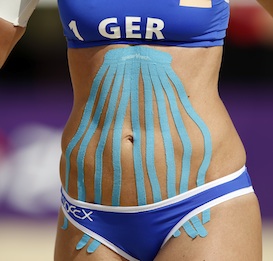Tale of the tape: Why Kinesio is the hottest accessory at the Games
Trendy therapeutic treatment has its benefits for athletes — real and imagined
Share

Retailers may have their hopes banked in patriotic T-shirts and London 2012 paraphernalia, but the buzziest product to emerge from this year’s games, it seems, is a simple piece of colourful tape.
It’s been spotted on Olympians from all over the world. German beach volleyball player Ilka Semmler sports a hot pink arrow on her behind and upper thighs; her teammate Katrin Holtwick has an octopus-looking design on her stomach; Greek judoka Ilias Iliadis revealed blue stripes of tape running up his lower back whenever his kimono lift; and China’s gold-medal winning synchronized springboard diver He Zi had applied the tape to her back and ankles. The list goes on.

So what’s all the hype about? Here’s the deal: Kinesio tape is an elastic therapeutic tape used for treating sports injuries. When a muscle is swollen, the space between it and the skin becomes compressed, which is painful. Kinesio tape lifts the skin, easing pain and absorbing inflammation.The tape is designed to be about the weight and thickness of skin, and stays put for about five days.
What’s truly bizarre, though, is that Kinesio tape isn’t anything new. It was developed roughly 30 years ago by chiropractor Dr. Kenso Kase, but never really took off among athletes or weekend warriors until recently.
The trendiest accessory at London 2012 owes its success to the previous edition of the Summer Games. It was in Beijing that 50,000 rolls of the tape were donated to 58 countries. Since then, Kinesio tape has been spotted on such high-profile athletes as Serena Williams and David Beckham. British sprinter Dwain Chambers even found some with a Union Jack pattern, which he taped to his leg at this year’s European Athletics Championships in Helsinki. According to some sources, worldwide sales have tripled since 2008.

The sudden takeoff of Kinesio has also turned into a success story in Canada, where our very own SpiderTech fabricates its version of the stuff. They’ve been selling it all over London this summer, and their homepage endorsement comes from none other than Simon Whitfield. The company’s founder told the Toronto Star he has plans to take the tape into the larger retail market. And since only licensed physiotherapists can accurately apply the tape, Kinesio’s rainbow tape has heralded an industry mini-boom.
But physiotherapists and other doctors question whether this tape is that much better than other elastic adhesives available on the market. A study published in the Journal of Orthopaedic and Sports Physiotherapy reads:
“Kinesio tape may be of some assistance to clinicians in improving pain-free active range of movement immediately after tape application for patients with shoulder pain.”
But a recent review of the scientific literature on Kinesio tape, published in the Sports Medicine journal determined that there is:
“…little quality evidence to support the use of Kinesio tape over other types of elastic taping in the management or prevention of sports injuries.”
Athletes and their trainers insist that the science just hasn’t caught up with the product. And some researchers note the placebo effect might be all that matters. Steve Harridge, a professor of human and applied physiology at King’s College London, told Reuters:

“The fact that athletes think it’s going to do them some good can help in a psychological way.”
So for Kinesio makers and marketers, it seems, it’s win-win situation – at least as long as the hype lasts.